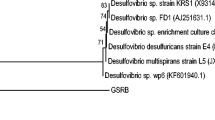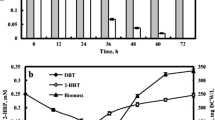Abstract
Three types of coimmobilized methanogenic and methanotrophic bacterial beads – Ca-alginate, Ba-alginate, and Ca-alginate chitosan – were used for tetrachloroethene (PCE) degradation. For the purpose of effective preparation of coimmobilized bacterial beads, the diameter and broken-loading of beads were measured. The activity tests to find the optimal bacteria concentration in the bead were performed. It was found that Ba-alginate beads had superiority in bacterial growth and the degree of strength of beads from the diameter and broken-loading tests. Also, it was shown that it is most effective to add 200 mL of methanogens into 500 mL of 2% alginate solution and 20 mL of methanotrophs into 500 mL to 2% alginate solution. When methanogens and methanotrophs were applied with the Ba-alginate bead in the actual dechlorination of PCE, the biological PCE dechlorination rate was 92%, and there was highly effective degradation of PCE based on the coimmobilized bead. Additionally, relation to the diameter (X) and broken-loading (Y) of the Ba-alginate bead was derived following equation, Y = 438.02 exp(–1.4815 X).
Similar content being viewed by others
References
Axtell RC & Guzman DR (1987) Encapsulation of the mosquito fungal pathogen Lagenidium giganteum toomyeeres: lagenidiates in calcium alginate. J. Am. Mosq. Control Assoc. 3: 450–459
Chevalier P & J de la Noue (1985)Wastewater nutrient removal with microalgae immobilized in carrageenan. Enzyme Microbiol. Technol. 7: 621–624
Fravel DR, Marois JJ & Connick Jr. WJ (1985) Encapsulation of potential biocontrol agents in an alginate-clay matrix. Phytopathology 75: 774–777
Freedman DL & Gossett JM (1989) Biological reductive dechlorination of tetrachloroethylene to ethylene under methanogenic conditions. Appl. Envir. Microbiology 55: 2144–2151
Fry IV & Mehlhorn (1994) Polyurethane and alginate-immobilized algal biomass for the removal of aqueous toxic metals. In: Means JI & Hinchee RE (Eds) Emerging Technology for Bioremediation of Metals (pp 130–134). CRC Press, Florida
Gerritse J, Renard V, Visser J & Gottschal JC (1995) Complete degradation of tetrachloroethene by combining anaerobic dechlorinating and aerobic methanotrophic enrichment cultures. Appl. Microbiol. Biotechnol. 43: 920–928
Hirata T, Nakasugi O, Yoshioka M & Sumi K (1992) Ground pollution by volatile organochlorines in Japan and related phenomena in the subsurfaces environment. Water Sci. Technol. 25: 9–16
Kanasawud P, Hjorleifsdottir S, Holst O & Mattjasson B (1989) Studies on immobilization of the thermophilic hacterium Thermus aquatiens YT-1 by entrapment in various matriees. Appl. Microbiol. Biotechnol 31: 228–233
Karsten G & Simon H (1993) Immobilization fo Protens vulgaris for the reduction of 2-oxo acids with hydrogen gas or formate to D2-hydroxt acids. Appl. Microbiol. Biotechnol. 38: 441–446
Kolot FB (1981) Microbial carriers-strategy for selection. Process Biochem. 5: 2–9
Kurosawa, H & Tanaka H (1990) Advances in immobilized cell culture: development of co-immobilized mixed culture system of aerobic and anaerobic micro-organisms. Biochem. International: 189–196
Park, S., Hanna, M. L., Taylor R. Y., and Droege, M. W. (1991) Batch cultivation of Methylosinus trichosporium OB3b. I: production of soluble methane monooxygenase. Biotechnol. Bioeng. 38: 423–433
Parsons F, Wood PR & Demarco JJ (1984) Transformation of tetrachloroethane in microcosms and groundwater. J. Am. Water Works Assoc. 76: 56–59
Veliky IA & Williams RE (1981) The production of ethanol by Saccharomyces cerevisiae immobilized in polycation-stabilized calcium alginate gels. Biotechnol. Lett. 3: 275–280
Vogel TM & McCarty PL (1985) Biotransformation of tetrachloroethylene to trichloroethylene, dichloroethylene, vinyl chloride, and carbon dioxide under methanogenic conditions. Appl. Envir. Microbiol. 49: 1080–1083
Author information
Authors and Affiliations
Corresponding author
Rights and permissions
About this article
Cite this article
Sung-In, Y., Youn-Kyoo, C. & Byung-Chan, L. Effective Bead Preparation of Coimmobilized Methanogenic and Methanotrophic Bacteria for Tetrachloroethene Degradation. Biodegradation 14, 347–355 (2003). https://doi.org/10.1023/A:1025660111453
Issue Date:
DOI: https://doi.org/10.1023/A:1025660111453




